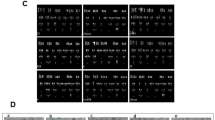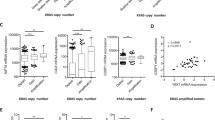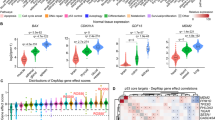Abstract
An improved understanding of cell immortalization and its manifestation in clinical tumors could facilitate novel therapeutic approaches. However, only rare tumor cells, which maintain telomerase expression in vitro, immortalize spontaneously. By expression-profiling analyses of limited-life primary breast tumor cultures pre- and post-hTERT transduction, and spontaneously immortalized breast cancer cell lines, we identified a common signature characteristic of tumor cell immortalization. A predominant feature of this immortalization signature (ImmSig) was the significant overexpression of oxidoreductase genes. In contrast to epithelial cells derived from low histologic grade primary tumors, which required hTERT transduction for the acquisition of ImmSig, spontaneously immortalizing high-grade tumor cultures displayed similar molecular changes independent of exogenous hTERT. Silencing the hTERT gene reversed ImmSig expression, increased cellular reactive oxygen species levels, altered mitochondrial membrane potential and induced apoptotic and proliferation changes in immortalized cells. In clinical breast cancer samples, cell-proliferation-pathway genes were significantly associated with ImmSig. In these cases, ImmSig expression itself was inversely correlated with patient survival (P=0), and was particularly relevant to the outcome of estrogen receptor-positive tumors. Our data support the notion that ImmSig assists in surmounting normal barriers related to oxidative and replicative stress response. Targeting a subset of aggressive breast cancers by reversing ImmSig components could be a practical therapeutic strategy.
This is a preview of subscription content, access via your institution
Access options
Subscribe to this journal
Receive 50 print issues and online access
$259.00 per year
only $5.18 per issue
Buy this article
- Purchase on Springer Link
- Instant access to full article PDF
Prices may be subject to local taxes which are calculated during checkout





Similar content being viewed by others
References
Ben-Porath I, Weinberg RA . (2005). The signals and pathways activating cellular senescence. Int J Biochem Cell Biol 37: 961–976.
Bodnar AG, Ouellette M, Frolkis M, Holt SE, Chiu CP, Morin GB et al. (1998). Extension of life-span by introduction of telomerase into normal human cells. Science 279: 349–352.
Boyle EI, Weng S, Gollub J, Jin H, Botstein D, Cherry JM et al. (2004). GO:TermFinder – open source software for accessing Gene Ontology information and finding significantly enriched Gene Ontology terms associated with a list of genes. Bioinformatics 20: 3710–3715.
Chang HY, Nuyten DS, Sneddon JB, Hastie T, Tibshirani R, Sorlie T et al. (2005). Robustness, scalability, and integration of a wound-response gene expression signature in predicting breast cancer survival. Proc Natl Acad Sci USA 102: 3738–3743.
Chen QM, Bartholomew JC, Campisi J, Acosta M, Reagan JD, Ames BN . (1998). Molecular analysis of H2O2-induced senescent-like growth arrest in normal human fibroblasts: p53 and Rb control G1 arrest but not cell replication. Biochem J 332: 43–50.
Counter CM, Avilion AA, LeFeuvre CE, Stewart NG, Greider CW, Harley CB et al. (1992). Telomere shortening associated with chromosome instability is arrested in immortal cells, which express telomerase activity. EMBO J 11: 1921–1929.
Dairkee SH, Deng G, Stampfer MR, Waldman FM, Smith HS . (1995). Selective cell culture of primary breast carcinoma. Cancer Res 55: 2516–2519.
Dairkee SH, Ji Y, Ben Y, Moore DH, Meng Z, Jeffrey SS . (2004). A molecular ‘signature’ of primary breast cancer cultures; patterns resembling tumor tissue. BMC Genomics 5: 47.
Dairkee SH, Paulo EC, Traquina P, Moore DH, Ljung BM, Smith HS . (1997). Partial enzymatic degradation of stroma allows enrichment and expansion of primary breast tumor cells. Cancer Res 57: 1590–1596.
Dudognon C, Pendino F, Hillion J, Saumet A, Lanotte M, Segal-Bendirdjian E . (2004). Death receptor signaling regulatory function for telomerase: hTERT abolishes TRAIL-induced apoptosis, independently of telomere maintenance. Oncogene 23: 7469–7474.
Elkak AE, Meligonis G, Salhab M, Mitchell B, Blake JR, Newbold RF et al. (2005). hTERT protein expression is independent of clinicopathological parameters and c-Myc protein expression in human breast cancer. J Carcinog 4: 17.
Kurz DJ, Decary S, Hong Y, Trivier E, Akhmedov A, Erusalimsky JD . (2004). Chronic oxidative stress compromises telomere integrity and accelerates the onset of senescence in human endothelial cells. J Cell Sci 117: 2417–2426.
Li Z, Bustos V, Miner J, Meng ZH, Zlotnikov G, Ljung BM et al. (1998). Propagation of genetically altered tumor cells derived from fine-needle aspirates of primary breast carcinoma. Cancer Res 58: 5271–5274.
Liang X, Lu B, Scott GK, Chang CH, Baldwin MA, Benz CC . (1998). Oxidant stress impaired DNA-binding of estrogen receptor from human breast cancer. Mol Cell Endocrinol 146: 151–161.
Ma XJ, Wang Z, Ryan PD, Isakoff SJ, Barmettler A, Fuller A et al. (2004). A two-gene expression ratio predicts clinical outcome in breast cancer patients treated with tamoxifen. Cancer Cell 5: 607–616.
Masutomi K, Possemato R, Wong JM, Currier JL, Tothova Z, Manola JB et al. (2005). The telomerase reverse transcriptase regulates chromatin state and DNA damage responses. Proc Natl Acad Sci USA 102: 8222–8227.
Michiels C, Toussaint O, Remacle J . (1990). Comparative study of oxygen toxicity in human fibroblasts and endothelial cells. J Cell Physiol 144: 295–302.
Paik S, Shak S, Tang G, Kim C, Baker J, Cronin M et al. (2004). A multigene assay to predict recurrence of tamoxifen-treated, node-negative breast cancer. N Engl J Med 351: 2817–2826.
Perou CM, Sorlie T, Eisen MB, Aas T, Geisler S, Johnsen H et al. (2000). Molecular portraits of human breast tumours. Nature 406: 747–752.
Schiff R, Reddy P, Ahotupa M, Coronado-Heinsohn E, Grim M, Hilsenbeck SG et al. (2000). Oxidative stress and AP-1 activity in tamoxifen-resistant breast tumors in vivo. J Natl Cancer Inst 92: 1926–1934.
Serrano M, Blasco MA . (2001). Putting the stress on senescence. Curr Opin Cell Biol 13: 748–753.
Shami PJ, Sauls DL, Weinberg JB . (1998). Schedule and concentration-dependent induction of apoptosis in leukemia cells by nitric oxide. Leukemia 12: 1461–1466.
Smith LL, Coller HA, Roberts JM . (2003). Telomerase modulates expression of growth-controlling genes and enhances cell proliferation. Nat Cell Biol 5: 474–479.
Sorlie T, Perou CM, Tibshirani R, Aas T, Geisler S, Johnsen H et al. (2001). Gene expression patterns of breast carcinomas distinguish tumor subclasses with clinical implications. Proc Natl Acad Sci USA 98: 10869–10874.
Sorlie T, Tibshirani R, Parker J, Hastie T, Marron JS, Nobel A et al. (2003). Repeated observation of breast tumor subtypes in independent gene expression data sets. Proc Natl Acad Sci USA 100: 8418–8423.
Sotiriou C, Wirapati P, Loi S, Harris A, Fox S, Smeds J et al. (2006). Gene expression profiling in breast cancer: understanding the molecular basis of histologic grade to improve prognosis. J Natl Cancer Inst 98: 262–272.
Stampfer MR, Garbe J, Levine G, Lichtsteiner S, Vasserot AP, Yaswen P . (2001). Expression of the telomerase catalytic subunit, hTERT, induces resistance to transforming growth factor beta growth inhibition in p16INK4A(-) human mammary epithelial cells. Proc Natl Acad Sci USA 98: 4498–4503.
Storz P . (2005). Reactive oxygen species in tumor progression. Front Biosci 10: 1881–1896.
Tusher VG, Tibshirani R, Chu G . (2000). Significance analysis of microarrays applied to the ionizing radiation response. Proc Natl Acad Sci USA 98: 5116–5121.
van de Vijver MJ, He YD, van’t Veer LJ, Dai H, Hart AA, Voskuil DW et al. (2002). A gene-expression signature as a predictor of survival in breast cancer. N Engl J Med 347: 1999–2009.
van’t Veer LJ, Dai H, van de Vijver MJ, He YD, Hart AA, Mao M et al. (2002). Gene expression profiling predicts clinical outcome of breast cancer. Nature 415: 530–536.
Wang J, Feng H, Huang XQ, Xiang H, Mao YW, Liu JP et al. (2005). Human telomerase reverse transcriptase immortalizes bovine lens epithelial cells and suppresses differentiation through regulation of the ERK signaling pathway. J Biol Chem 280: 22776–22787.
Wu YL, Dudognon C, Nguyen E, Hillion J, Pendino F, Tarkanyi I et al. (2006). Immunodetection of human telomerase reverse-transcriptase (hTERT) re-appraised: nucleolin and telomerase cross paths. J Cell Sci 119: 2797–2806.
Xiang H, Wang J, Mao Y, Liu M, Reddy VN, Li DW . (2002). Human telomerase accelerates growth of lens epithelial cells through regulation of the genes mediating RB/E2F pathway. Oncogene 21: 3784–3791.
Zhang P, Chan SL, Fu W, Mendoza M, Mattson MP . (2003). TERT suppresses apoptosis at a premitochondrial step by a mechanism requiring reverse transcriptase activity and 14-3-3 protein-binding ability. FASEB J 17: 767–769.
Acknowledgements
We thank Dr Janos Demeter and Dr Wenzhong Xiao (Stanford University) for helpful suggestions on the Bioinformatic aspects of this study. This research was supported by NIH R01CA109325 (SHD), NIH K01 HG00030 (MN) and NIH U01 CA85129 (SSJ) and by funds from the California Breast Cancer Research Program of the University of California, grant numbers 8WB-0032 (SHD) and 10 EB-1086 (SSJ).
Author information
Authors and Affiliations
Corresponding authors
Additional information
Supplementary Information accompanies the paper on the Oncogene website (http://www.nature.com/onc).
Supplementary information
Rights and permissions
About this article
Cite this article
Dairkee, S., Nicolau, M., Sayeed, A. et al. Oxidative stress pathways highlighted in tumor cell immortalization: association with breast cancer outcome. Oncogene 26, 6269–6279 (2007). https://doi.org/10.1038/sj.onc.1210452
Received:
Revised:
Accepted:
Published:
Issue Date:
DOI: https://doi.org/10.1038/sj.onc.1210452
Keywords
This article is cited by
-
Chronic oxidative stress causes estrogen-independent aggressive phenotype, and epigenetic inactivation of estrogen receptor alpha in MCF-7 breast cancer cells
Breast Cancer Research and Treatment (2015)
-
Depletion of RUNX1/ETO in t(8;21) AML cells leads to genome-wide changes in chromatin structure and transcription factor binding
Leukemia (2012)
-
Negative regulation of UCP2 by TGFβ signaling characterizes low and intermediate-grade primary breast cancer
Cell Death & Disease (2010)
-
Hdm2 negatively regulates telomerase activity by functioning as an E3 ligase of hTERT
Oncogene (2010)
-
Genes responsive to both oxidant stress and loss of estrogen receptor function identify a poor prognosis group of estrogen receptor positive primary breast cancers
Breast Cancer Research (2008)



